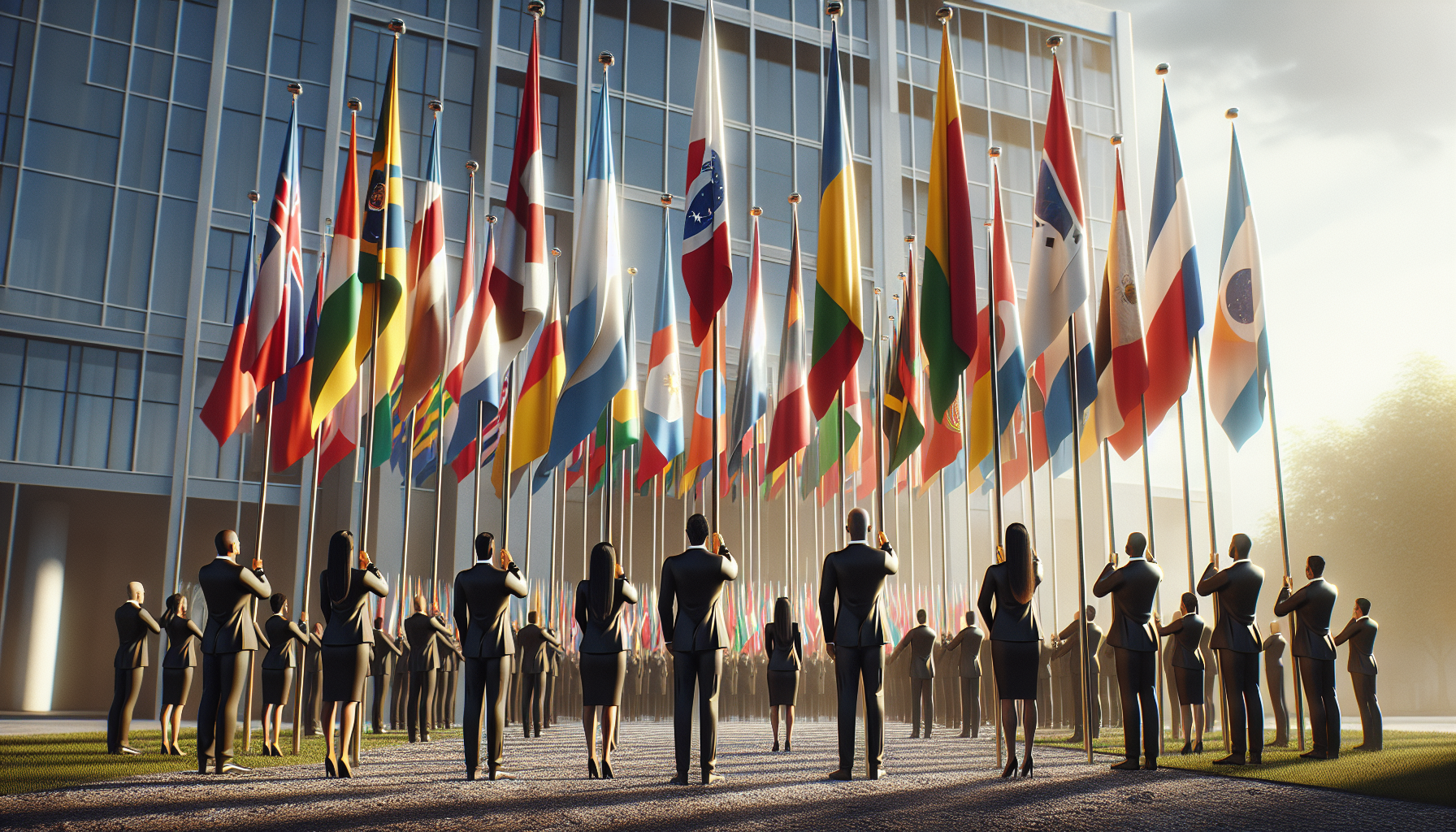Flags have long been more than mere pieces of fabric fluttering in the wind; they are potent symbols, vibrant markers of identity, unity, and sovereignty. In the grand theatre of international relations, the act of raising a flag can resonate far beyond its immediate visual impact, echoing through diplomatic channels and influencing geopolitical landscapes. Welcome to a deep dive into the fascinating world of flag raising as a political statement—a nuanced dance of symbolism and power that has, for centuries, played a pivotal role in the way nations communicate and assert themselves on the global stage. 🌍
From ancient battlefields to modern-day summits, the symbolic act of hoisting a flag has served myriad purposes. It has declared conquests, celebrated victories, and mourned losses. In contemporary settings, the ritual of flag raising continues to be a significant tool of diplomacy. But what makes this gesture so powerful? And how does it serve as a barometer for international relations? To unravel these questions, we must first understand the intricate layers of meaning and intention behind each wave of a flag, each ceremonial lifting of a national emblem into the sky.
As we journey through this exploration, we will examine key historical moments when flag raising was used as a deliberate diplomatic maneuver, altering the course of relationships between countries. We’ll delve into the symbolism inherent in this act and how it has been harnessed to project power, signal shifts in alliances, or assert independence. Moreover, we will explore the psychological impact on both domestic and international audiences when a flag is raised in specific contexts—how it can unite, provoke, or reassure, depending on the intention behind the gesture.
Finally, this article will highlight contemporary examples of flag raising that continue to shape political narratives today. From the UN headquarters to contentious territories around the globe, the decision to hoist a flag remains a potent statement of presence and intent. Join us as we uncover the stories behind these symbolic acts, examining how they not only reflect but also shape the political realities of our world. Whether you’re a history enthusiast, a student of politics, or simply curious about the power of symbols, this exploration promises to be as enlightening as it is engaging. 🎌
The Historical Significance of Flag Raising
Flag raising has long been a powerful symbol of national identity and unity. The practice of raising a flag, often seen as a simple act, holds profound implications and historical significance. The concept of a flag as a representation of a nation’s ideals, history, and aspirations can be traced back to ancient civilizations, where flags were used to identify groups and signal intentions during warfare. The tradition evolved, becoming more structured and imbued with deeper meaning over time.
In the context of modern diplomacy, flag raising serves as a potent political statement. It is a visual expression of sovereignty and solidarity, often used during state visits, international events, and diplomatic ceremonies. The act of hoisting a flag in another country can signal friendship, recognition, and support. Conversely, the absence of a flag, or the lowering of a flag, can indicate diplomatic tensions or disapproval. The symbolic nature of flags in diplomacy was especially evident during the Cold War, where flags were strategically used to convey political allegiances and ideological stances.
A historical example is the flag raising at Iwo Jima during World War II, which became a symbol of American perseverance and victory. This iconic image underscores how flag raising transcends mere symbolism, becoming a rallying point for collective national pride. In contemporary settings, the raising of a flag during diplomatic negotiations can be a subtle yet profound gesture, reflecting changes in political relationships and the acknowledgment of new global dynamics. Thus, understanding the historical context of flag raising enriches our appreciation of its role in international affairs today.
Flag Raising as a Diplomatic Tool
The strategic use of flag raising in diplomacy cannot be overstated. It serves as a tool for communicating intentions and positions without the need for words. This non-verbal communication method is particularly effective in sensitive political climates, where spoken words may be misinterpreted or exacerbate tensions. Flag raising can affirm alliances, signal diplomatic shifts, or demonstrate a nation’s commitment to international treaties and agreements.
For instance, when a nation joins international organizations like the United Nations or the European Union, the raising of their flag at these institutions signifies their acceptance and integration into the global community. This act is not just ceremonial; it is a declaration of shared values and mutual recognition. Similarly, during state visits, the host country often raises the visiting country’s flag alongside its own. This gesture of goodwill and respect underscores the importance of bilateral relations and fosters an atmosphere of collaboration and dialogue.
The impact of flag raising in diplomacy is further highlighted by its use in protests and demonstrations. Activists and political movements often raise flags to symbolize their cause and draw international attention. This practice was evident in the protests in Hong Kong, where the raising of certain flags became emblematic of the struggle for autonomy and democratic freedoms. In such contexts, flag raising transcends its traditional diplomatic role, becoming a powerful means of political expression and advocacy. As global dynamics continue to evolve, the strategic use of flag raising in diplomacy will remain a crucial element in international relations.
Case Studies: Flag Raising in Action
Examining specific case studies provides deeper insights into the power and purpose of flag raising as a political statement. One notable example is the flag raising ceremony at the Olympic Games, where athletes from around the world gather to compete. The raising of national flags during medal ceremonies serves not only to honor individual achievements but also to celebrate national pride and unity. This global stage highlights the intersection of sports and diplomacy, where flags play a central role in fostering peaceful competition and international camaraderie.
Another significant case is the flag raising at the United Nations headquarters. This act represents a nation’s commitment to peace and cooperation, as well as its acceptance into the international community. When South Sudan became the 193rd member of the United Nations in 2011, the raising of its flag marked a new chapter in its national history, symbolizing its newfound sovereignty and the challenges ahead in building a stable nation.
In contrast, the absence or removal of a flag can carry equally powerful political messages. For example, during the Arab Spring, the toppling of flags became a symbolic act of resistance and change. In these instances, the act of flag raising—or its absence—serves as a barometer of political climates and public sentiment. These case studies demonstrate the multifaceted nature of flag raising, highlighting its enduring relevance in contemporary political discourse.
Table: Symbolic Flag Raising Events
| Event | Year | Significance |
|---|---|---|
| Iwo Jima Flag Raising | 1945 | Symbol of American victory in World War II |
| UN Membership Flag Raising for South Sudan | 2011 | Signified sovereignty and international recognition |
| Olympic Games Medal Ceremonies | Ongoing | Celebration of national pride and international unity |
For more context on the powerful symbolism of flag raising, watch this video: “The Power of Flags in Diplomacy” – Diplomacy Channel
The Psychological Impact of Flag Raising
Beyond its diplomatic implications, flag raising also exerts a psychological impact on individuals and communities. Flags are imbued with emotional and cultural significance, serving as tangible symbols of identity, belonging, and heritage. The act of raising a flag can evoke feelings of pride, solidarity, and unity, reinforcing a sense of shared purpose and collective identity.
Psychologists have studied the impact of national symbols, such as flags, on group cohesion and morale. The presence of a national flag can enhance feelings of patriotism and motivate individuals to act in alignment with national values and goals. This psychological effect is particularly evident during national holidays, sporting events, and commemorative ceremonies, where the raising of the flag becomes a focal point for collective celebration and remembrance.
Moreover, the psychological impact of flag raising extends beyond national borders. In multicultural and multinational contexts, flags can serve as bridges, fostering understanding and respect among diverse groups. The raising of multiple flags in international events, such as the World Cup or the United Nations Assembly, symbolizes the coexistence of different cultures and the potential for peaceful collaboration. As such, the psychological dimensions of flag raising contribute to its powerful role in both national and international arenas.
Future Trends in Flag Raising Practices
As we look to the future, the practices and implications of flag raising are likely to evolve in response to changing geopolitical landscapes and technological advancements. The digital age offers new opportunities for the display and dissemination of national symbols, including flags. Virtual flag raising ceremonies and digital representations of flags on social media platforms are becoming increasingly common, allowing for broader participation and engagement in national and international events.
Additionally, the rising importance of environmental sustainability may influence future flag raising practices. As nations commit to reducing their environmental footprint, there may be a shift towards eco-friendly materials and methods for flag production and display. This trend reflects a growing awareness of the need to align national symbols with broader global sustainability goals.
Furthermore, the future of flag raising may be shaped by the ongoing dialogue around inclusivity and representation. As societies become more diverse, there is a growing recognition of the need to represent multiple identities and narratives within national symbols. This could lead to the adoption of new flag designs or the incorporation of additional symbols to reflect the diverse communities within a nation. The evolution of flag raising practices will continue to reflect and influence the complex dynamics of global politics and cultural identities.
- Explore how flag raising ceremonies can be adapted for virtual platforms.
- Consider the environmental impact of flag production and explore sustainable alternatives.
- Reflect on the role of flags in representing diverse cultural identities within nations.

Conclusion
**Conclusion: Embracing the Power and Purpose of Flag Raising**
As we reach the conclusion of our exploration into the dynamic world of flag raising as a political statement, it is essential to reflect on the key themes we have unraveled and their implications on the global stage. The ritual of hoisting a flag is far more than a mere ceremonial act; it is a potent symbol of identity, unity, and political intent. Flags have the extraordinary ability to communicate complex messages without uttering a single word, and their use in diplomacy and political expression is both timeless and timely.
**Recap of Key Points**
Firstly, we delved into the historical roots of flag raising, tracing its origins to ancient civilizations where banners were used to demarcate territories and convey authority. This historical perspective set the stage for understanding how flag raising has evolved into a sophisticated tool in contemporary diplomacy. It is fascinating to observe how a practice steeped in tradition has adapted to modern contexts, serving as a bridge between the past and the present.
Secondly, we examined the various contexts in which flag raising is employed today. Whether it is during state visits, international summits, or protests, the act of raising a flag is imbued with meaning. We highlighted how different countries and political entities leverage this practice to assert sovereignty, express solidarity, or challenge the status quo. Each instance of flag raising is a carefully orchestrated performance, aimed at conveying a specific message to a targeted audience.
Additionally, we discussed the psychological impact of flag raising on both national and international communities. The imagery of a flag fluttering in the wind can evoke a deep sense of pride and belonging among citizens, reinforcing national identity and unity. On the international stage, the raising of a foreign flag can signify respect and diplomacy, fostering a spirit of cooperation and mutual understanding.
**The Importance of the Theme**
Understanding the power and purpose of flag raising is crucial in today’s interconnected world. As nations navigate complex geopolitical landscapes, the symbolic actions they undertake can have far-reaching consequences. Flag raising is not merely about showcasing colors and emblems; it is about wielding influence and shaping perceptions. By appreciating the nuances of this practice, diplomats, policymakers, and citizens alike can engage more thoughtfully in global dialogues.
Moreover, flag raising serves as a reminder of the values and principles that underpin our societies. In moments of triumph and tragedy, flags are raised to honor achievements, mourn losses, and inspire hope. They stand as beacons of resilience and defiance, urging us to strive for a world that upholds the ideals of peace, justice, and equality.
**Inspiring Action and Engagement**
As we conclude our discussion, I invite you, the reader, to consider the role you play in this ongoing narrative. Flags may be raised by governments and institutions, but their true power lies in the hearts and minds of individuals. Let us be mindful of the messages we send and the values we endorse through the symbols we choose to elevate.
Engage with this topic by sharing your thoughts and experiences. Have you witnessed a flag raising ceremony that left a lasting impression? What emotions did it evoke, and why? Share your insights in the comments section below, and let’s foster a vibrant conversation on the significance of flag raising in our lives.
Furthermore, consider sharing this article with friends and colleagues who may find value in this discussion. By spreading awareness and understanding, we contribute to a more informed and empathetic global community.
In closing, may we all be inspired by the profound simplicity of a flag being raised—a reminder that even in a world divided by borders, we are united by shared hopes and aspirations. 🌍🚩
For further reading on this topic, you may explore this resource on the symbolism of flags and this insightful article on the role of flags in diplomacy. These sources provide additional depth and perspectives that complement our discussion.
Thank you for joining me on this journey into the world of flag raising as a political statement. Let us continue to raise our flags high, with purpose and pride.
Toni Santos is a visual storyteller and artisan whose creations celebrate the poetry of the natural world. Through his thoughtful artistic lens, Toni captures the elegance of botanical forms, transforming them into meaningful expressions of symbolism, resilience, and timeless beauty.
His journey is deeply rooted in a passion for flora and the mysteries they carry. From the shape of a petal to the curve of a vine, each design Toni brings to life reflects a deeper narrative — one of growth, transformation, and harmony with nature. Whether crafting symbolic floral jewelry, enchanted botanical illustrations, or seasonal visual studies, Toni’s work evokes the quiet magic found in Earth’s most delicate details.
With a background in handcrafted artistry and visual design, Toni blends technique with intention. His creations do more than decorate — they speak, often inspired by ancient meanings behind flowers, the cycles of the seasons, and the invisible bonds between nature and spirit.
As the creative voice behind Vizovex, Toni shares this botanical journey with the world, offering curated stories, handcrafted collections, and thoughtful articles that help others reconnect with nature’s symbolism and artistic essence.
His work is a tribute to:
The quiet power of flowers and their messages
The art of visual symbolism in everyday life
The beauty of slowing down to see what’s hidden in plain sight
Whether you’re an artist, a nature lover, or someone drawn to the deeper meanings behind the natural world, Toni welcomes you to explore a space where aesthetics meet soul — one petal, one story, one creation at a time.





